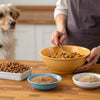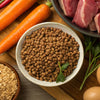Is Kibble the Best Food for Dogs? Exploring the Pros and Cons
- Houndsy
Table of Contents
- Introduction
- Understanding Kibble: What Is It?
- The Nutritional Debate: Kibble vs. Fresh and Raw Food
- The Case for Kibble: Is It the Best Choice?
- Transitioning to Kibble: Tips for Pet Owners
- Conclusion
Introduction
Have you ever glanced at your dog’s food bowl and wondered if you’re truly providing the best nutrition for your furry friend? According to a survey conducted by the American Veterinary Medical Association, a staggering 60% of dog owners are unsure about the nutritional value of their dog’s food. With the rise of fresh and raw diets, the question of whether kibble is the best food for dogs has become increasingly relevant. In this blog post, we will dive into the various types of dog food available, with a particular focus on kibble, and help you understand the implications of your choices.
Our mission at Houndsy is to simplify and elevate the dog-feeding experience, ensuring that every meal contributes positively to your dog’s health and happiness. By the end of this article, you'll have a comprehensive understanding of kibble, its benefits and drawbacks, and how it compares to alternative diets like fresh and raw food. We'll also explore how our Houndsy Kibble Dispenser can enhance your dog-feeding routine, making it easier to provide consistent, high-quality meals.
Understanding Kibble: What Is It?
Kibble is a type of dry dog food that has been a staple in pet diets for decades. It is typically made through an extrusion process, where ingredients like meat, grains, and vegetables are cooked at high temperatures and then formed into small bite-sized pieces. This method allows for a longer shelf life and convenience, but it raises questions about the nutritional quality of the food.
The Ingredients in Kibble
The ingredient list in kibble can vary significantly from brand to brand. Common components include:
- Protein Sources: Ideally, quality kibbles list real meat (e.g., chicken, beef, or lamb) as the first ingredient. However, many lower-quality brands use meat byproducts, which can include less nutritious parts of animals.
- Grains and Carbohydrates: These often include corn, wheat, and soy, which can be hard for some dogs to digest and may lead to allergies in sensitive pups.
- Vitamins and Minerals: To make up for nutrient loss during processing, vitamins and minerals are often added back into the kibble.
Nutritional Benefits of Kibble
Kibble comes with several potential benefits:
- Convenience: Kibble is easy to store, measure, and serve. It doesn't require refrigeration and has a long shelf life.
- Cost-Effectiveness: Compared to fresh or raw diets, kibble is generally more budget-friendly, making it accessible for many dog owners.
- Dental Health: Some kibble brands claim to help reduce tartar buildup due to their crunchy texture, which can promote dental hygiene.
Despite these benefits, many pet owners are questioning whether kibble is the best choice for their dogs, especially given the growing awareness of alternative diets.
The Nutritional Debate: Kibble vs. Fresh and Raw Food
As pet parents, it’s essential to consider the impact of diet on our dogs' health. While kibble has been the go-to option for years, the rise of fresh and raw diets has prompted a reevaluation of its role in canine nutrition.
Fresh Dog Food: A Viable Alternative?
Fresh dog food is made with whole ingredients that are minimally processed. Brands like Ollie and The Honest Kitchen have gained popularity for their commitment to providing real food that meets the nutritional needs of dogs.
Benefits of Fresh Food
- Higher Nutritional Value: Fresh food is often richer in nutrients, as it retains more vitamins and minerals due to minimal processing.
- Better Digestibility: Many dogs find fresh food easier to digest, which can lead to improved stool quality and overall health.
- Hydration: Fresh food typically contains higher moisture content, which can help keep dogs hydrated and support overall health.
Raw Dog Food: The Controversial Option
Raw dog food diets consist of uncooked meats, bones, and organs, along with fruits and vegetables. While some advocates tout the benefits of a raw diet, it comes with its own set of challenges and risks.
Potential Pros of Raw Diets
- Natural Ingredients: Raw diets aim to mimic what dogs would eat in the wild, focusing on high-quality protein sources.
- Improved Health Markers: Some dog owners report benefits such as shinier coats and increased energy levels after transitioning to a raw diet.
Risks of Raw Diets
- Bacterial Contamination: Raw meat can harbor dangerous bacteria like Salmonella and E. coli, which pose risks to both dogs and humans.
- Nutritional Imbalance: Without careful planning, raw diets can lack essential nutrients required for a balanced canine diet.
The Case for Kibble: Is It the Best Choice?
So, is kibble the best food for dogs? The answer isn't straightforward and depends on various factors, including your dog's specific needs, health, and lifestyle.
Pros of Feeding Kibble
- Convenience: No need for meal prep or refrigeration—just scoop and serve.
- Affordability: Kibble is generally more budget-friendly than fresh or raw options.
- Variety: Many brands offer a range of flavors and formulations tailored to different breeds, sizes, and health needs.
- Shelf Stability: Kibble can be stored for long periods without spoiling, making it a practical choice for busy pet owners.
Cons of Feeding Kibble
- Processing: The high-temperature processing can destroy nutrients, making it essential for manufacturers to add synthetic vitamins and minerals.
- Ingredient Quality: Not all kibbles are created equal; low-quality brands may include fillers and byproducts that offer limited nutritional value.
- Digestive Issues: Some dogs may experience gastrointestinal problems due to the high carbohydrate content and low moisture levels in kibble.
- Potential Allergens: Many kibbles contain common allergens like grains that can trigger sensitivities in some dogs.
Transitioning to Kibble: Tips for Pet Owners
If you've decided that kibble is the right choice for your dog, here are some tips to ensure a smooth transition and optimize your dog's feeding routine:
1. Choose High-Quality Kibble
Look for kibbles that list real meat as the first ingredient and avoid those with fillers and artificial preservatives. Brands that prioritize high-quality ingredients, like those available through our Houndsy Kibble Dispenser, can make a significant difference in your dog’s health.
2. Gradual Transition
When switching your dog to a new kibble, do so gradually over a week to avoid digestive upset. Start with a mix of the old and new food, gradually increasing the proportion of the new kibble.
3. Monitor Your Dog’s Health
Keep an eye on your dog’s weight, energy levels, and overall health during the transition. Regular vet check-ups can help ensure your dog is thriving on their new diet.
4. Incorporate Fresh Ingredients
Consider adding fresh fruits or vegetables to your dog's kibble for added nutrients and variety. Just make sure these are safe for dogs—options like carrots, blueberries, and pumpkin can be excellent choices.
5. Invest in a Quality Kibble Dispenser
A product like the Houndsy Kibble Dispenser can simplify the feeding process with its perfect portion control and ergonomic design, making mealtime a breeze. Plus, it keeps kibble fresh and free from contamination.
Conclusion
The question of whether kibble is the best food for dogs ultimately depends on various factors, including your dog's unique nutritional needs, health status, and lifestyle. While kibble offers convenience and affordability, it's essential to be mindful of the quality of the ingredients and how it fits into your dog's overall diet.
As dedicated pet owners, we must strive to provide the best nutrition for our dogs, whether that means sticking with high-quality kibble, exploring fresh food options, or considering raw diets. We at Houndsy encourage you to evaluate your choices carefully and consider how our Houndsy Kibble Dispenser can help elevate your dog-feeding experience.
By prioritizing your dog's nutrition, you not only enhance their quality of life but also strengthen the bond you share with your beloved companion. For more information and to explore our products, visit our Houndsy Kibble Dispenser page.
FAQ
1. Can I mix kibble with fresh food?
Yes! Many pet owners successfully mix kibble with fresh food to provide a balanced diet. Just ensure that you're not overfeeding and monitor your dog's health.
2. How do I know if my dog is allergic to kibble?
Signs of food allergies can include itching, digestive upset, and skin problems. If you suspect an allergy, consult your veterinarian for testing and dietary recommendations.
3. How often should I feed my dog kibble?
Feeding schedules can vary based on your dog's age, size, and activity level. Consult your veterinarian for personalized feeding guidelines.
4. What should I look for in high-quality kibble?
Look for meat as the first ingredient, a balance of protein and fats, and no fillers or artificial preservatives. Brands that prioritize quality ingredients, like Houndsy, can provide better nutrition for your dog.
5. Is it safe to switch my dog’s food suddenly?
It's best to transition gradually over a week to minimize digestive upset. Mix the old food with the new kibble in increasing proportions to help your dog adjust.












